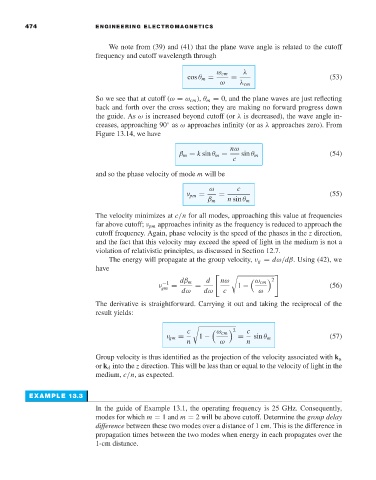Page 492 - Engineering Electromagnetics, 8th Edition
P. 492
474 ENGINEERING ELECTROMAGNETICS
We note from (39) and (41) that the plane wave angle is related to the cutoff
frequency and cutoff wavelength through
ω cm λ
cos θ m = = (53)
ω λ cm
So we see that at cutoff (ω = ω cm ), θ m = 0, and the plane waves are just reflecting
back and forth over the cross section; they are making no forward progress down
the guide. As ω is increased beyond cutoff (or λ is decreased), the wave angle in-
creases, approaching 90 as ω approaches infinity (or as λ approaches zero). From
◦
Figure 13.14, we have
nω
β m = k sin θ m = sin θ m (54)
c
and so the phase velocity of mode m will be
ω c
ν pm = = (55)
β m n sin θ m
The velocity minimizes at c/n for all modes, approaching this value at frequencies
far above cutoff; ν pm approaches infinity as the frequency is reduced to approach the
cutoff frequency. Again, phase velocity is the speed of the phases in the z direction,
and the fact that this velocity may exceed the speed of light in the medium is not a
violation of relativistic principles, as discussed in Section 12.7.
The energy will propagate at the group velocity, ν g = dω/dβ. Using (42), we
have
−1 dβ m d nω ω cm 2
ν gm = = 1 − (56)
dω dω c ω
The derivative is straightforward. Carrying it out and taking the reciprocal of the
result yields:
c ω cm 2 c
ν gm = 1 − = sin θ m (57)
n ω n
Group velocity is thus identified as the projection of the velocity associated with k u
or k d into the z direction. This will be less than or equal to the velocity of light in the
medium, c/n,asexpected.
EXAMPLE 13.3
In the guide of Example 13.1, the operating frequency is 25 GHz. Consequently,
modes for which m = 1 and m = 2 will be above cutoff. Determine the group delay
difference between these two modes over a distance of 1 cm. This is the difference in
propagation times between the two modes when energy in each propagates over the
1-cm distance.

